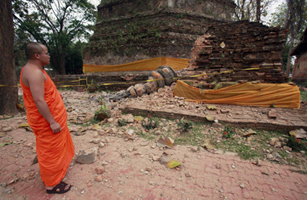
Aid workers said Friday that at least 120 people were killed by the magnitude 6.8 earthquake that hit Thursday, rattling high-rises in Bangkok and sending people streaming into the streets of Hanoi. Details of the disaster were slowly seeping out from Shan State in northeastern Burma, a relatively remote region near the border with Laos and Thailand in the heart of the area known as the Golden Triangle. Homes, monasteries and government offices were among the 390 buildings damaged or destroyed, according to Burma’s state-run media.
Burma’s government put the death toll at 74 and 111 injured. But a reporter working for The Irrawaddy who traveled to the quake zone on Friday, said local Red Cross officials confirmed 120 dead, with the figure expected to rise. He also said that the military was tightening checkpoints along the border. During the last natural disaster to hit Burma — Cyclone Nargis in 2008 — the government was criticized for placing state security over humanitarian concerns and refusing international relief workers access to the disaster area in a timely fashion. There has been no call yet from the Burmese government for international assistance in dealing with the latest quake.
Although Burma’s state-run media reported on the earthquake promptly on Thursday evening, no video footage was shown Thursday or Friday. The only image was in a state-run newspaper that showed a damaged bathroom in a home. The government is, nonetheless, becoming more open about disasters than in the past. During the 1980s, a large section of the city of Mandalay was destroyed by fire, but news did not reach the outside world until a Western journalist traveled there nearly five years later. Burma’s rulers, and many of its people, are notoriously superstitious, and disasters, natural or otherwise, or seen as portents of bad fortune to come.
Thursday’s earthquake was centered near the small towns of Loimwe, and was just six miles below the ground’s surface, according to the United States Geological Survey. The mountains of Shan State are the foothills of the Himalayas where the Indo-Australian plate butts up against the Eurasian plate. Earthquakes in northern Burma are fairly common, but details are often sketchy because the area is remote and Burma’s government keeps a tight rein on information. Parts of Shan State are notoriously lawless, places where ethnic militias smuggle drugs, weapons, people and other contraband across the Mekong River and into Laos and Thailand. Some use the proceeds to fund insurgencies against the government, while others are allied with the government.